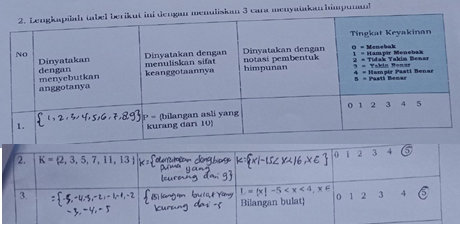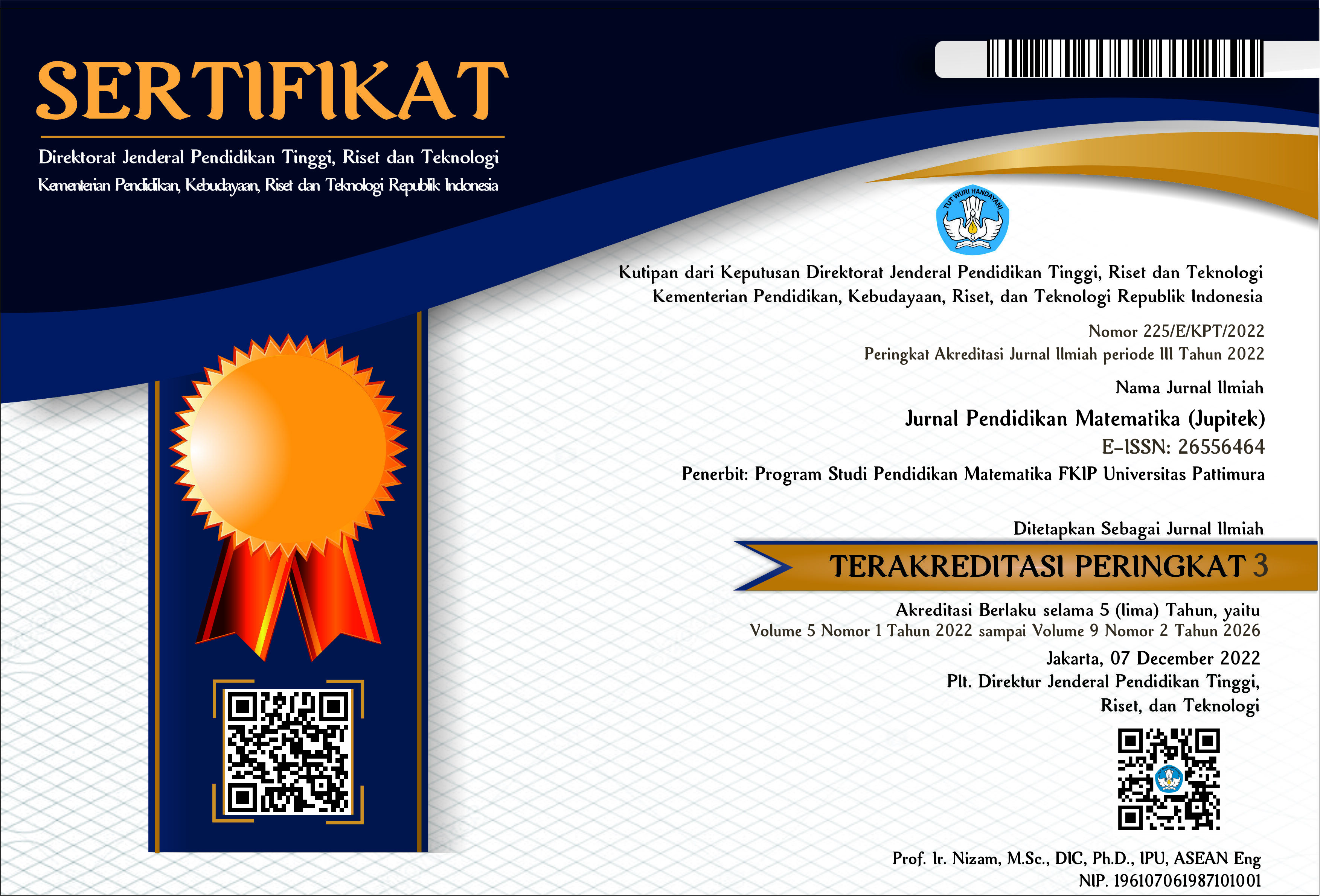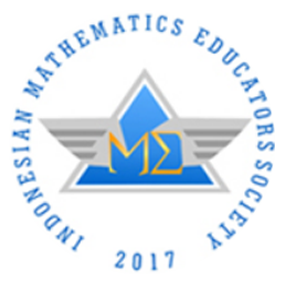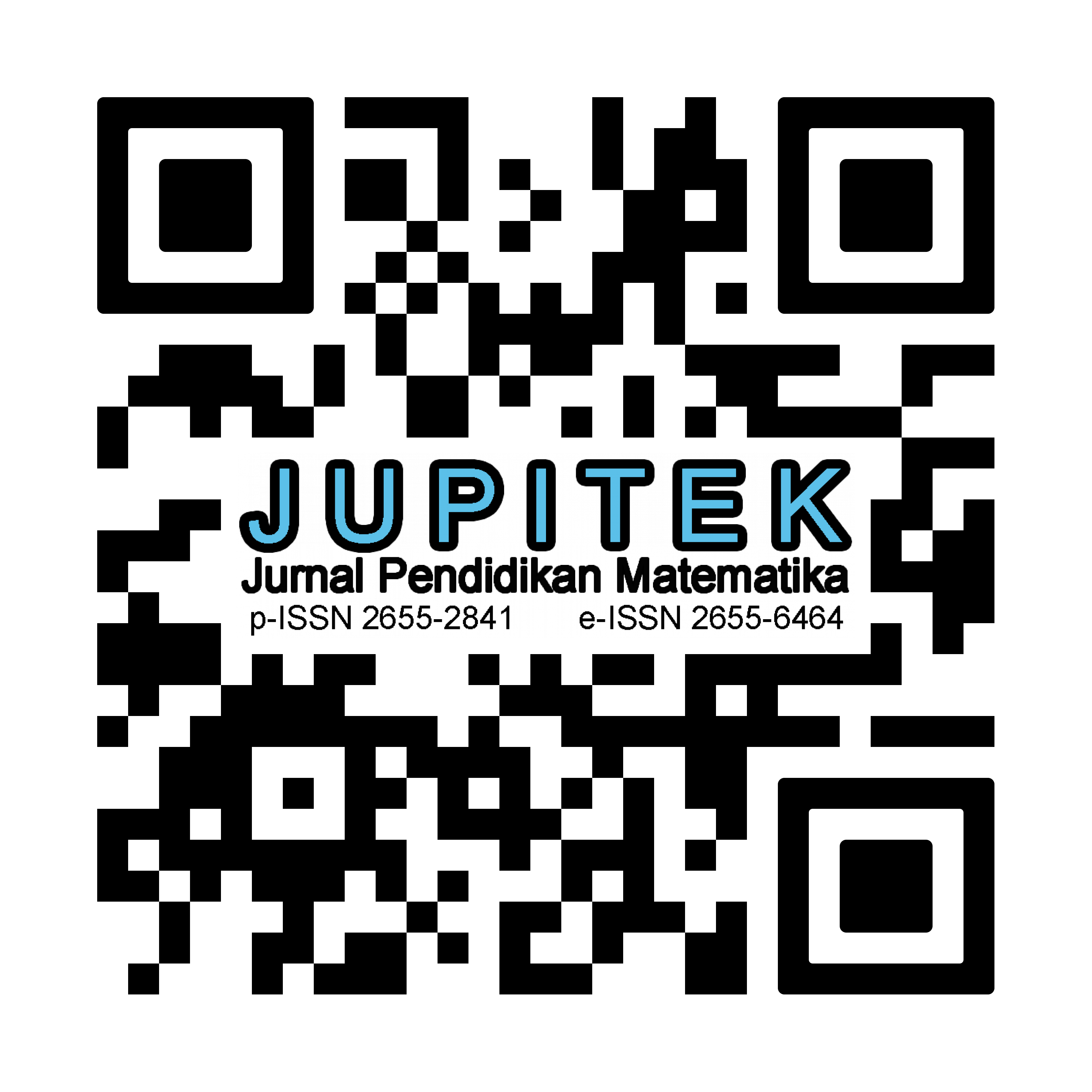MISKONSEPSI MAHASISWA PADA MATERI HIMPUNAN: ANALISIS MENGGUNAKAN KRITERIA CERTAINTY OF RESPONSE INDEX
Abstract
This research aims to find out the misconceptions of students about the concept of the set using certainty of response index (CRI) indicators. The research subjects consisted of 89 students who programmed the Introduction to Basic Mathematics (PDM) course. The research method used is qualitative descriptive. A written test consisting of 4 reasoned multiple choice and descriptive questions were used to collect research data. The results showed that based on CRI criteria, for problem number 1 about the differences of set and not sets, there were 39% of students experiencing misconceptions, 33% of students do not know the concept and 28% of students who know the concept correctly. In question number 2, the questions about three ways of presenting a set of natural, whole, prime and integers numbers, it was found that 12% of students experienced misconceptions and 76% of students did not know the concept because of guessing and lack of knowledge, the remaining 11% of students understand the concept very well. For problem number 3, about the operation of the set found that 30% of students experienced misconceptions, 45% did not know the concept and the remaining 24% understood the concept correctly. Furthermore, for problem number 4, the set operation story was obtained the result that of 19% of students who took the test experienced misconceptions, 57% of students did not understand the concept and only 24% of students understood the concept correctly. In other words, of the 4 questions that were tested on students, questions number 1 and 3 were mostly found by students experiencing misconceptions. Although problem number 2, it was found that at least students experienced misconspection but in this questions almost 80% of students did not know the concept correctly
Downloads
References
Alonemarera, A. S. (2020). Identifikasi Miskonsepsi Mahasiswa Pendidikan Biologi Pada Materi Genetika Menggunakan Certainty of Response Indeks (Cri). Jurnal Biotek, 8(2), 109. https://doi.org/10.24252/jb.v8i2.16320
Aygor, N., & Ozdag, H. (2012). Misconceptions in Linear Algebra: the Case of Undergraduate Students. Procedia - Social and Behavioral Sciences, 46(2002), 2989–2994. https://doi.org/10.1016/j.sbspro.2012.05.602
Fadillah, S. (2017). Analisis Miskonsepsi Siswa Smp Dalam Materi Perbandingan Dengan Menggunakan Certainty of Response Index (Cri). Jurnal Pendidikan Informatika Dan Sains, 5(2), 247–259. http://www.journal.ikippgriptk.ac.id/index.php/saintek/article/view/349
Fitria, A. (2014a). Miskonsepsi Mahasiswa Dalam Menentukan Grup Pada Struktur Aljabar Menggunakan Certainty Of Response Index (Cri) Di Jurusan Pendidikan Matematika IAIN Antasari. Jurnal Pendidikan Matematika, 1(2), 45–60. https://doi.org/10.18592/jpm.v1i2.50
Fitria, A. (2014b). Miskonsepsi Mahasiswa Dalam Menentukan Grup Pada Struktur Aljabar Menggunakan Certainty Of Response Index (Cri) Di Jurusan Pendidikan Matematika IAIN Antasari. Jurnal Pendidikan Matematika, 1(2), 45. https://doi.org/10.18592/jpm.v1i2.50
Hasan, S., Bagayoko, D., & Kelley, E. L. (1999). Misconceptions and the certainty of response index (CRI). Physics Education, 34(5), 294–299. https://doi.org/10.1088/0031-9120/34/5/304
Helmi, H., Rustaman, N. Y., Tapilow, F. S., & Hidayat, T. (2019). Preconception analysis of evolution on pre-service biology teachers using certainty of response index. Journal of Physics: Conference Series, 1157(2). https://doi.org/10.1088/1742-6596/1157/2/022033
Kefi, M. E., Disnawati, H., & Suddin, S. (2021). Analisis Kesulitan Siswa Dalam Menyelesaikan Soal Relasi Menggunakan Certainty of Response Index (Cri). Jurnal Pendidikan Matematika (Jupitek), 4(1), 21–26. https://doi.org/10.30598/jupitekvol4iss1pp21-26
Mujib, A. (2017). I Dentifikasi M Iskonsepsi M Ahasiswa M Enggunakan Cri Pada. Mushorafa, 6(2), 181–192.
Putra, I. E., Adlim, A., & Halim, A. (2016). Analisis Miskonsepsi Dan Upaya Remediasi Pembelajaran Listrik Dinamis Dengan Menggunakan Media Pembelajaran Lectora Inspire Dan PhET Simulation Di Sman Unggul Tunas Bangsa. Jurnal Pendidikan Sains Indonesia (Indonesian Journal of Science Education), 4(2), 13-19
Putri, R.E., Hasan, S. (2021). Analisis Miskonsepsi Menggunakan Metode Four-Tier Certainty Of Response Index: Studi Eksplorasi Di Smp Negeri 60 Surabaya. Pensa E-Jurnal: PENDIDIKAN SAINS, 9(2), 220–226.
Qurrota, A., & Nuswowati, M. (2018). Analisis Miskonsepsi Siswa Menggunakan Tes Diagnostic Multiple Choice Berbantuan Cri (Certainty of Response Index). Jurnal Inovasi Pendidikan Kimia, 12(1), 2108–2117.
Rahmawati, N. K., Kusuma, A. P. (2019). Hubungan Pemahaman Konsep Aritmatika Sosial Dengan Hasil Belajar Ips Materi Pph. Buana Matematika : Jurnal Ilmiah Matematika Dan Pendidikan Matematika, 9(1:), 1–6. https://doi.org/10.36456/buana_matematika.9.1:.1976.1-6
Ramadhan, Y., Nisa, K., R., & Sunarwin, S. (2020). Analysis of Students Misconception Using Certainly of Response Index (CRI) in the Periodic System of Elements Concept. EduChemia (Jurnal Kimia Dan Pendidikan), 5(2), 210. https://doi.org/10.30870/educhemia.v5i2.8285
Sadhu, S., Tima, M. T., Cahyani, V. P., Laka, A. F., Annisa, D., & Fahriyah, A. R. (2017). Analysis of acid-base misconceptions using modified certainty of response index (CRI) and diagnostic interview for different student levels cognitive. International Journal of Science and Applied Science: Conference Series, 1(2), 91. https://doi.org/10.20961/ijsascs.v1i2.5126
Saragih, A. (2018). Kelas Xi Mipa Sma Analysis Of Student ’ S Misconceptions On The Concepts Of The Human Nervous System Using Concept Map In Class XI MIPA SMA Adelina Saragih Universitas Negeri Medan , Medan Email : saragihadelina3@gmail.com PENDAHULUAN Penelitian ini berti. Prosiding Seminar Nasional Biologi Dan Pembelajarannya Universitas Negeri Medan.
Suwarna, I. P. (2017). Analisis Miskonsepsi Siswa Sma Kelas X Pada Mata Pelajaran Fisika Melalui Cri I (Certainty Of Response Index) Termodifikasi. Prisiding.
Treagust, D. F. (2012). Diagnostic assessment in science as a means to improving teaching, learning and retention. UniServe Science Assessment Symposium Proceedings, 1(1), 1–9. http://www.tamu.edu/mars/assess/HTMLfiles/oabooks.html%0Ahttp://www.edu.u-szeged.hu/~csapo/publ/Reading_Framework_English.pdf#page=215%0Ahttp://www.ntk.hu/c/document_library/get_file?uuid=4fdfc630-1445-41e5-b8ab-2020c6a135cc&groupId=10801%0Ahttp://openjou
Udil, Afrisno, Amsikan, P., & Oktovianus, N. (2020). Analisis Miskonsepsi Siswa Kelas Viii Smpn Loro Tuan Pada Materi Pola Bilangan Dengan Certanty of Response Index (Cri). Asimtot : Jurnal Kependidikan Matematika, 2(2), 139–152. https://doi.org/10.30822/asimtot.v2i2.770
Waluyo, E. M., Muchyidin, A., & Kusmanto, H. (2019). Analysis of Students Misconception in Completing Mathematical Questions Using Certainty of Response Index (CRI). Tadris: Jurnal Keguruan Dan Ilmu Tarbiyah, 4(1), 27–39. https://doi.org/10.24042/tadris.v4i1.2988

Copyright (c) 2021 Hermina Disnawati, Yohanis Ndapa Deda

This work is licensed under a Creative Commons Attribution-NonCommercial-ShareAlike 4.0 International License.
License and Copyright Agreement
By submitting a manuscript to Jurnal Pendidikan Matematika (JUPITEK), the author(s) certify and agree to the following terms:
- Originality and Authority: The submitting author is authorized by all co-authors to enter into this agreement. The manuscript describes original work that has not been published previously in a peer-reviewed journal, nor is it under consideration for publication elsewhere.
- Approval: Its publication has been approved by all author(s) and by the responsible authorities of the institutions where the work was carried out.
- Rights: The authors secure the right to reproduce any material that has already been published or copyrighted elsewhere.
- Licensing and Copyright: Authors retain the copyright to their work.
- License Grant: The authors grant Jurnal Pendidikan Matematika (JUPITEK) the right of first publication, with the work simultaneously licensed under the Creative Commons Attribution-NonCommercial-ShareAlike 4.0 International (CC BY-NC-SA 4.0).
- Self-Archiving: Authors are permitted and encouraged to deposit the published version of their article in institutional repositories, on their personal websites, and other academic platforms, with proper acknowledgment of its initial publication in Jurnal Pendidikan Matematika (JUPITEK).





.png)


